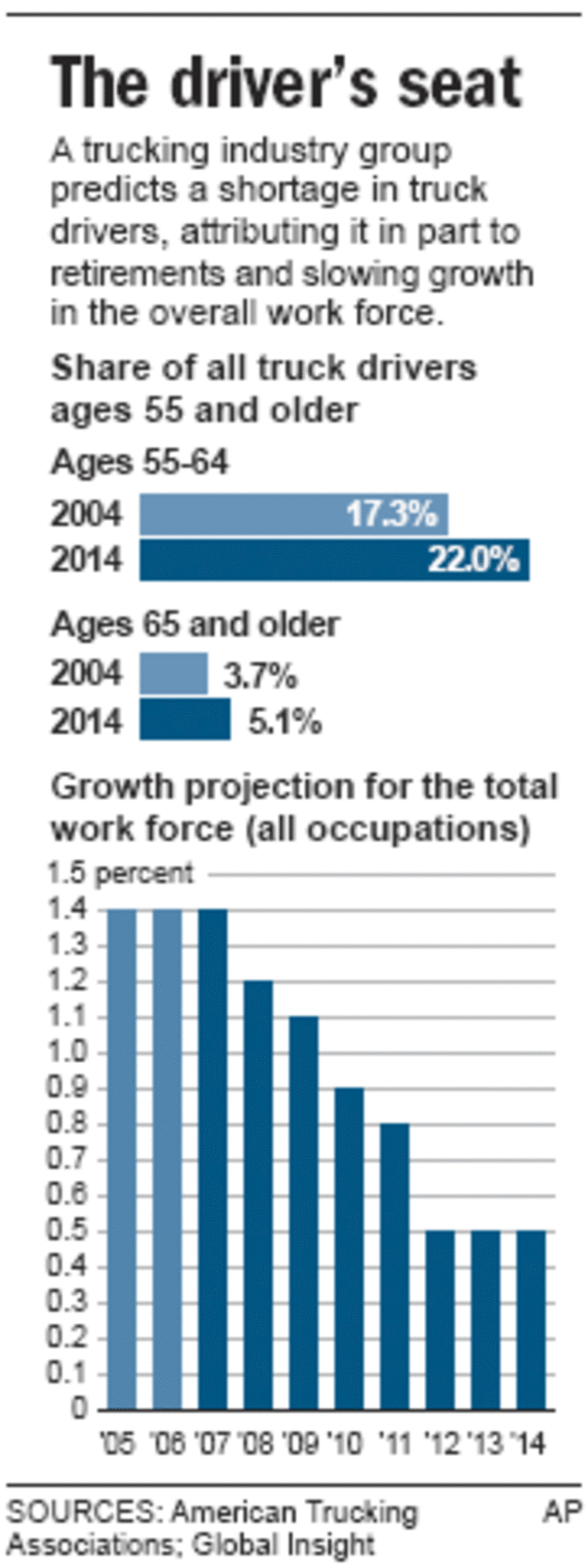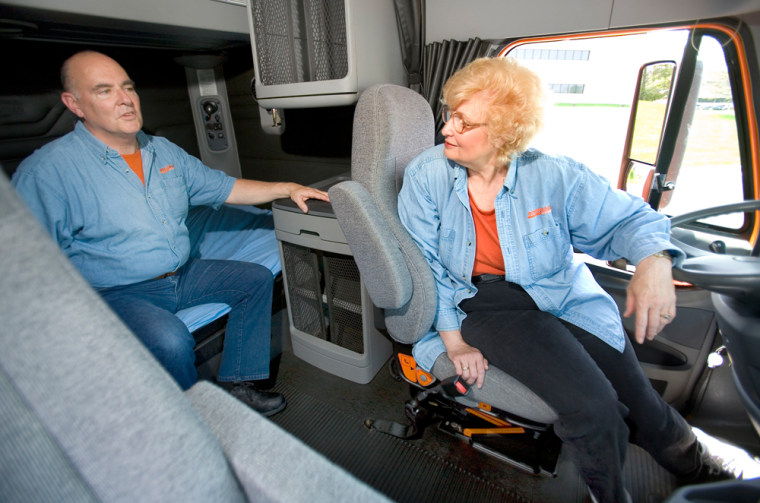Jim and Eva Sisler began traveling the country nearly 10 years ago, a couple of empty nesters in their 50s with a desire to see new places and build some assets before retirement.
Driving from California to New Jersey in two days, using layovers to visit historic sites in the South or ethnic restaurants in Chicago, the Sislers pack in a lot. Back in Montana, they revel in the simple pleasures of home. It’s a nice change from life in an 18-wheel truck.
U.S. trucking companies want more people like the Sislers, to deal with what the companies fear will be a worsening shortage of long-haul drivers. The industry is launching an ad campaign for recruitment and is particularly interested in older couples, free of concerns about missed family time and perhaps looking to replace worn-out jobs with new ones before retirement. Putting two at the wheel helps business. The hours a truck legally can operate double and freight arrives sooner. Some of the customers demanding just-in-time deliveries, which cut the need for large inventories and warehousing, pay extra for team driving.
It works for the Sislers, who began driving in 1998 after moving from California to Montana to help their son build a house. With that project finished, Jim looked for work, alarmed his wife by enrolling in truck-driver training — often a three- to six-week course — and suggested she do the same.
“I said, ’You can do this, too, darlin. You can be a truck driver,”’ he said.
When Jim drove urban buses in California and Eva was a homemaker, both knew they’d be home every night. Now they sleep mostly in a truck, usually one of them in the cab’s bed while the other drives. Home is a place in Big Arm, along sprawling Flathead Lake in northwestern Montana. Paid by the mile, the Sislers together earned more than $100,000 last year as drivers for Watkins & Shepard Trucking Co. and have built a retirement account.
The United States has about 1.3 million drivers of long-haul, heavy trucks, roughly 20,000 fewer than needed, according to American Trucking Associations, an industry group based in Alexandria, Va. A 2005 study the associations commissioned projects a shortage of 111,000 drivers by 2014, a gap attributed partly to retirements and inadequate recruitment, plus increased demand for trucking.

Additionally, federal security requirements were tightened after the Sept. 11, 2001, attacks. The government established new requirements for transporting hazardous materials and many companies prefer drivers authorized to transport those materials. In the right quantity, a load of butane lighters and certain cleaning supplies constitute hazardous material.
Sen. Barbara Boxer, D-Calif., Friday asked the Department of Homeland Security to set tougher guidelines for truckers transporting gasoline and other hazardous materials after a gasoline tanker exploded and caused the collapse of a San Francisco-area freeway ramp. The truck had been cited for repeated safety violations; the driver previously had his license revoked or suspended.
The driver shortage doesn’t mean requirements will be softened, said Tiffany Wlaslowski, spokeswoman for American Trucking Associations.
“Motor carriers are choosy about who they hire and are only looking to hire the best,” she said.
Reaching out to a larger segment of the labor force is critical to the future of an industry long reliant on men working solo, said Ray Kuntz, Watkins & Shepard chief executive and incoming chairman of the associations. The study found drivers cited time away from home and unpredictable schedules for getting home as reasons for quitting more often than money.
Long-distance haulers of general freight averaged $17.62 an hour in February, according to the U.S. Department of Labor, which calls the job outlook favorable.
The trucking associations’ national advertising campaign is being rolled out gradually, first in Montana, Minnesota and Oklahoma. Romanticizing the work, one billboard silhouettes trucks on a bridge at sunset and boasts, “my office has a better view than yours.” A recruitment Web site, www.gettrucking.com, tells visitors “the road is calling.” The campaign includes TV commercials, print advertising and pitches at bus stops. A wrapping for truck trailers makes them into mobile signs with the message that driving a big rig is a great career.
“We are looking for the husband-wife team, folks looking for a second career, people who want to see the country,” said Elisabeth Barna, a vice president for American Trucking Associations.
Individually, many companies looking for drivers pay bonuses for successful referrals. Epes Transport System in Greensboro, N.C., finds current drivers who like their jobs and spread the word are the most effective recruitment tool, director of recruiting Jeff Olsen said. Kansas-based Yellow Transportation offers a training program aimed at troops who are finishing military service and have driven trucks or operated heavy equipment. They get conditional job offers, with a choice of locations.
Obtaining a commercial drivers license requires medical certification and compliance with “higher physical, mental and emotional standards” than drivers of passenger cars must satisfy, said Duayne DeBruyne, spokesman for the Federal Motor Carrier Safety Administration. The medical certification must be repeated every 24 months, and in some cases it can be required as often as every 90 days, he said. States issue the commercial licenses to drive and are responsible for seeing that federal regulations are met.
Joey and Terri Lynch of Athens, Wis., became a driving team about 15 years ago after he lost the lease on his grocery in suburban Chicago and she left a job as a coats-and-dresses manager in a JCPenney store. “I worked in high heels and business suits for all that time, and then got in a truck,” said Terri, 59.
Schneider National puts the Lynches on the road for three weeks at a time followed by three off.
Calorie conscious because they spend so much time sitting, the Lynches travel with two small refrigerators for light snacks and eat a daily restaurant meal, usually lunch because the portions are smaller, the prices lower and the parking easier than at dinnertime.
“You can’t tell somebody whether they’re going to like driving a truck,” said Joey, who listens to audio books on the road. “You have to get out and try it.”
His wife likens living in a truck to sharing a home’s smallest bathroom with a partner for three weeks, with few breaks.
Trucker couples say squabbles are inevitable, but not a big problem for partners who truly know and like one another.
“We’ve been married for 42 years,” Jim Sisler said. “We know how to get on each other’s nerves, how to get off — and when.”
